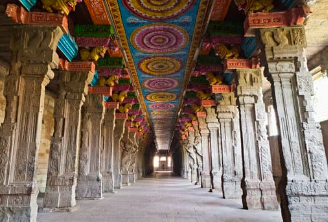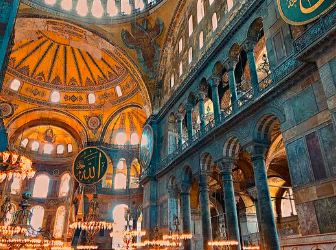What influenced colour in 400AD?
A.D. 400
The ancient Greek town of Byzantium, renamed Constantinople, had been made the capital of the Roman Empire during the 4th Century of the Christian Era.
Christianity had become the leading religion. Byzantine colouring was much influenced by the Persians, Egyptians and Greeks, from whose buildings many treasures were “borrowed” to beautify the new capital city.
The temples were often altered for use as Christian churches. They were plain outside, but the interiors were richly decorated with gilding and mosaics.

A.D. 500
For thousands of years civilisations had been developing all over the world, and by the year 500 many of them showed a high degree of perfection.
Colour meanings on buildings
In India, temples were resplendent with elaborate carvings, brilliant colouring applied with paint, mosaics and inlays made from precious stones.
From various associations, through the ages colour had developed a symbolism in the Far East and was used by that code. The roof tiles of Chinese royal buildings were yellow.
The roof tiles of private dwellings were green or blue, according to the rank of the owner. The beams and underside of the projecting roof and the interiors were elaborately ornamented and decorated with gold and vermilion lacquer and inlay.
Blue was the predominating colour effect of the temples and included tiles of deep cobalt. Pagodas were embellished with beautiful glazed tiles in deep purplish blue, rich green, yellow, red and turquoise blue. Wooden statues were covered with gesso and painted.
The exteriors of Japanese Buddhist temples were usually plain, but the interiors were lavishly adorned. The timbers were decorated with vermilion, blue, green, gilding and lacquer and the walls with fresco paintings. Motherof-Pearl and silver were worked into the ceilings, rich colour and gilding into the walls and black lacquer inlaid with ivory was used for partitions, etc.
A.D. 650
The Mohammedans in their mosques used wood, plaster and stone, ornamented with ivory, marble and coloured glass inlay. Fresco paintings decorated the walls, reflecting strong reds, yellows and blues, supplemented with gold.

A.D. 1000
The Christians were constructing their buildings of brick, stone and wood. The ornamentation of the interiors was not only decorative but had instructive value and was in the mediums of colourful fresco paintings and mosaic. In Constantinople, in the Church of Santa Sophia, built about 550, the interior was elaborately adorned and very colourful. Marbles of green, rose, white and deep red were used. The ceiling was of gold. Coloured enamels were applied, and ivory carvings were painted and gilded. Where civilisations had developed in the Americas, bright colours abound. The Mayans, who occupied lands now known as Yucatan and Guatemala, built of limestone, cement and concrete. Their structures were painted outside and inside with red, yellow, blue, black, purple and several greens. Murals were painted on both wet and dry plaster. The Aztecs, in what is now Mexico, built with concrete, faced with cut limestone. Their structures, like those of the Mayans, were highly coloured both inside and outside with paint and mosaics.

